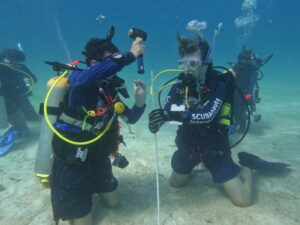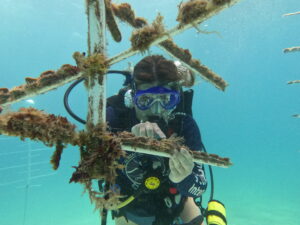SCUBAnauts has been diving in Key Largo for the past week. The Nauts and I have been given the opportunity to swim in coral reefs, see some snazzy sea creatures, and work with Mote Marine Laboratory and a few of their marine biologists.
On Wednesday our day started at 6:30, eating breakfast, gathering our diving gear, and ultimately traveling to the marina for our first excursion. When we arrived at our first dive location, we were greeted by a Mote biologist, who informed us of what we would be doing in order of conservation work. He explained that we would need to create an anchoring system required for constructing new coral trees. He also told us we would be cleaning coral trees by scrubbing the algae off that had rested atop the lining, and pulling new trees down from the surface to their correct resting place.
Dive One – Anchors

Nauts work in buddy teams to hammer duckbill anchors 3ft into the sand to hold future coral trees in place.
My first job was working on the anchoring system. My buddy and I followed Sam, who was a marine biologist at Mote and the leader of the anchoring site, to a fiberglass pole. From there we were told to put the pole into a metal duckbill anchor that was inserted into the sandy ocean floor. This kept the trees sturdy in the water.
Once my buddy and I let all of the air out of our BCD (buoyancy control device) we began hammering. This took us about 15-20 minutes per tree anchor and was a very tiring process. Each site had an instructor, who eyed our work and helped us when we needed assistance. Sam was very informative in explaining how to hammer effectively and showed us how to stand without bouncing up and down. I found it interesting how this large tree with multiple different branches and small parts depended on a little anchor as a foundation.
Dive Two – New Trees
After a quick air swap we dove back down and started working with Marty, another biologist from Mote, who showed us the rope maneuver that pulled the trees down from the surface. Something we had learned the day prior was tying knots, and we needed to use one of them on this job.
Each tree was weighed down by a cement block. We started by grabbing the ropes and doing a switch motion by grabbing some of the rope, letting go, holding more, and repeating that action until we pulled it down under the water to eye level. Finally, we threaded a smaller rope through the bottom and tied a pretzel knot to keep it in place. After all of the nauts in my group practiced and participated, we moved on to the final station, which was cleaning.
Dive Three – Cleaning
Cleaning was fairly simple, we began by swimming to the older trees and lightly scrubbing them with a brush to get rid of caked algae and any other organisms. This took very little time since we could clean fast. After we finished we were signaled to go back to the top and finish our dives for the day.

Cleaning trees to remove algae and other competing organisms is a critical part of nursery maintenance.
On the way back home, we all listened to some tunes and talked until we got back to our houses, then we ate some dinner and did dive logs, which consisted of logging all the dives we had done that day in detail.
Overall, I thoroughly enjoyed working with Mote, experiencing things from their points of view, and working hand-in-hand with scientific data was so cool! I’m very grateful to Mote for giving us this opportunity, and I can’t wait to go back and work with the nursery again.
–Eva E., Naut-in-Training, Savannah Chapter

